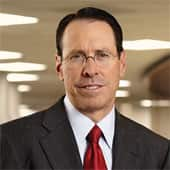From 2007 to 2014, mobile data traffic on our network increased 100,000%
Building the network of the future
A fundamental transformation
For the telecom business, the times are changing – and AT&T is leading the industry through a fundamental transformation.
The primary drivers are the rapid adoption of both wireless communication and streaming video, which together are causing a huge surge in bandwidth demand. One technology company projects video traffic of all kinds to account for 80-90 percent of all global consumer traffic on wireless networks by 2018. And the rapid spread of the Internet of Things (IoT) – connected cars, health monitoring, wearables and a range of other applications – will drive demand higher still.
From 2007 to 2014, mobile data traffic on our network increased 100,000 percent – and the growth shows no signs of slowing.

“You look at demand forecast based on the explosion of video and the explosion of the Internet of Things, and you can’t afford not to meet consumer demand. Mobile data traffic grew 100,000 percent over eight years. Video and IoT are going to go through the same growth curve, and by the way mobility doesn’t seem to be slowing down. We have to lower the costs of deploying the networks. And the only way to do that is to take the utilization of those networks materially higher.” – John Donovan, Senior Executive Vice President, AT&T Technology & Operations
The issue is simple: the traffic can’t be managed efficiently with technology that defined the telecom network until now.
Taking leadership
“We had to do something to handle this consumer demand,” said Krish Prabhu, president-AT&T Labs & chief technology officer. “We saw this problem first and we’re driving the industry toward the solution. We’re stepping up and taking a leadership role.”
The solution for managing this growth without straining the network boils down to shifting network control from hardware to software. It’s been proven in the IT industry – and we’re now applying it to the wide area network.
Two concepts are at the center of this strategy. Software-defined networking, or SDN, and network function virtualization, or NFV, revolutionized corporate data centers. SDN and NFV allow you to control data flows across a network using software, rather than physical switches, routers and other equipment, which require constant maintenance and updating. The concepts provide unique advantages, including a shift from expensive proprietary hardware to more economical standard servers.
“It’s something that some highly successful companies in Silicon Valley have achieved at a large scale,” said Jim Goetz, partner, Sequoia Capital. “For the carriers, it’s about taking that approach and using commodity technologies and open source and embracing it aggressively. It changes the underlying economics.”
This shift is at the core of our Domain 2.0 vendor plan. The program is designed to ensure our network can address accelerating bandwidth demand while also finding a way to dramatically improve the economics of the business. That opens the door to improved profitability.
More service, new opportunities
And there are other benefits. More people on the network doing more things gives AT&T an opening to sell more services to customers, with new opportunities for both us and third parties to create new applications and services.
Martin Casado, a Stanford networking guru who co-founded the pioneering SDN company Nicira, which was acquired by VMware in 2012, also says AT&T should benefit in multiple ways from a software-centric network. Increased supplier competition will mean better and cheaper systems, reduced operating costs and quicker innovation.
Already, we are far more active than any other carrier in working with Silicon Valley venture firms to direct and advise emerging players developing key software for the software-centric architecture.
While the shift is just getting started, our goal is to virtualize and control more than 75 percent of our network using this new architecture by 2020. “We are leading the charge,” Donovan said. “If you take AT&T out of the current mix, this thing occurs over a decade or more because of the aversion to risk. We’re trying to complete the journey in half that time or less.”

Leadership Insight
“Going forward, our network progression will be about software-defined networking — reshaping our network to be faster, more flexible and more cost effective.”– John Donovan, Senior Executive Vice President, AT&T Technology and Operations





















